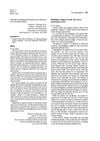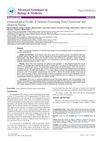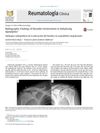Search
for
Sort by
Research
300-330 / 1000+ resultsresearch Alopecia Areata After HLA-Identical Bone Marrow Transplant from an Affected Sibling Donor
Alopecia areata can be transferred through stem cell transplants from affected siblings.

research Alopecia Areata: Clinical Review and Treatment Approaches
Alopecia Areata has no guaranteed treatment for hair regrowth, but options like corticosteroids and minoxidil are used, with future research focusing on genetic and immune therapies.

research Exacerbation of Alopecia Areata During Pegylated Interferon Alpha-2b and Ribavirin Therapy, Possibly Due to the Collapse of Hair Follicle Immune Privilege
A woman's hair loss worsened after starting hepatitis C treatment due to immune changes in her hair follicles.

research Pemphigus Vulgaris in Only One of Two Monozygotic Twins
Genetic factors alone might not cause pemphigus vulgaris; other factors like birth complications and puberty may trigger it.

research Alopecia Areata Is Associated With MICA and an Extended HLA Haplotype
Certain genes are linked to the risk of developing Alopecia Areata.

research Identification of Drug-Specific Public TCR Driving Severe Cutaneous Adverse Reactions
Researchers found a specific immune receptor in patients that causes severe skin reactions to a drug.
research Computer-Assisted Epitope Prediction Revealed Potential Autoantigens Associated with Human Alopecia Areata
Melanogenesis-related proteins may trigger immune responses in alopecia areata patients.

research The Genetic Basis of Dermatophytosis Skin Infection Susceptibility
Genetic factors affecting skin health and body weight may increase the risk of dermatophytosis.

research FOXN1 Deficient Nude Severe Combined Immunodeficiency
FOXN1 gene mutations cause a rare, severe immune disease treatable with cell or tissue transplants.

research Frontal Fibrosing Alopecia: A Review of Disease Pathogenesis
The cause of Frontal fibrosing alopecia, a type of hair loss, is complex, likely involving immune responses and genetics, but is not fully understood.

research Alopecia Areata Patients Show Deficiency of FOXP3+CD39+ T Regulatory Cells and Clonotypic Restriction of Treg TCRβ-Chain, Highlighting the Immunopathological Aspect of the Disease
Patients with Alopecia areata have fewer specific immune cells that normally regulate the immune system, which may contribute to the condition.
research Changes in Populations of HLA-DR+CD3+ Cells and CD57–CD16+ Cells in Alopecia Areata After Corticosteroid Therapy
Corticosteroid therapy reduces specific immune cells and promotes hair growth in alopecia areata patients.

research Alterations in Transcriptome and Antioxidant Activity of Naturally Aged Mice Exposed to Selenium-Rich Rice
Eating selenium-rich rice improved antioxidant activity and signs of aging in mice.
research Autoimmunity: Alopecia Areata
Alopecia areata is an autoimmune disease causing hair loss, treatable with immune-modulating drugs, and linked to genetics.

research Human FOXN1 Deficiency Is Associated with Alpha Beta Double-Negative and FoxP3 Positive T-Cell Expansions That Are Distinctly Modulated upon Thymic Transplantation
Thymic transplantation normalized some T-cells but not others, maintaining immune function.

research Dandruff Lesional Scalp Skin Exhibits Epidermal T Cell Infiltration and a Weakened Hair Follicle Immune Privilege
Dandruff is linked to increased T cells and weakened immune protection in hair follicles.

research Alterations in Epidermal Stem Cells Within the Pilosebaceous Unit in Atrophic Acne Scars
Inflammatory acne damages skin stem cells and reduces their growth, leading to atrophic acne scars.

research Hair Diseases: Alopecia Areata and Androgenetic Alopecia
Alopecia areata, a type of hair loss, may be passed through T cells and has genetic links, while treatments vary in effectiveness. Male pattern baldness can be treated with finasteride and is influenced by androgens in hair follicles.

research Lichen Simplex Chronicus Positive for C5b-9/MAC, IgD, and C3c Due to Recurrent Bacterial Hair Follicular Unit Infection
Chronic bacterial infections of hair follicles can cause ongoing skin inflammation.
research Skin Manifestations of Celiac Disease
A gluten-free diet significantly improves skin and health issues in people with dermatitis herpetiformis, a skin condition linked to celiac disease.

research The Spectrum of Hair Loss in Patients with Mycosis Fungoides and Sézary Syndrome
Some patients with mycosis fungoides or Sézary syndrome experience hair loss, which may be similar to alopecia areata or linked to skin lesions, possibly due to abnormal T cells, and bexarotene can help treat it.

research Genetics of Alopecia
Different genes are linked to various types of hair loss.

research Alopecia Areata Update
Half of people with Alopecia Areata may see hair regrowth within a year without treatment, but recovery is unpredictable.

research Immunological Profile of Patients with Down Syndrome and Alopecia Areata
Down Syndrome patients with Alopecia Areata often have hypothyroidism and specific immune abnormalities.

research Radiographic Findings of Shoulder Involvement in Ankylosing Spondylitis
The patient with Ankylosing Spondylitis had shoulder joint damage and bone changes.
research Significance of HLA-DR+ T Cells and Natural Killer Cells in the Peripheral Blood Lymphocytes of Alopecia Areata
Severe alopecia areata involves higher levels of certain immune cells, which can be normalized with betamethasone.
research Epidermolysis Bullosa Acquisita Occurring in a Patient with Systemic Lupus Erythematosus
A woman with lupus also developed a severe skin condition linked to a genetic factor.

research Familial Aggregation of Alopecia Areata
Alopecia areata, a common autoimmune hair loss condition, often runs in families.

research Frontal Fibrosing Alopecia: Clinical Patterns and Associations
Frontal Fibrosing Alopecia is a hair loss condition mainly affecting postmenopausal women, with unclear causes and various clinical patterns.